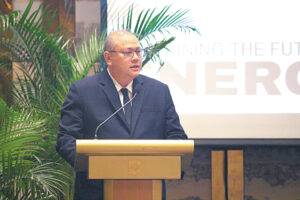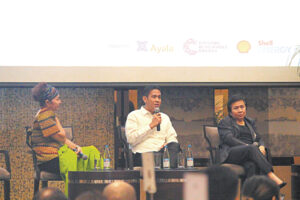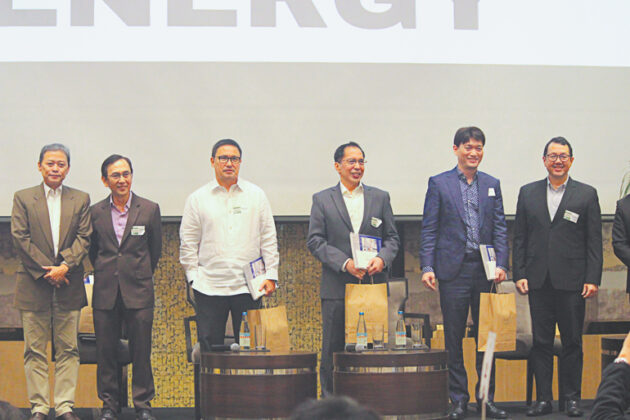Trailblazing a path towards a cleaner energy grid

By Bjorn Biel M. Beltran, Special Features and Content Assistant Editor
Momentum for the clean energy transition is bigger than it ever has been before, driven by the rapid advancement of key technologies that aim to revolutionize the world’s energy systems.
In fact, the International Energy Agency (IEA), in their latest “Tracking Clean Energy Progress” report released last July, pointed out that clean energy technologies like solar PV and electric vehicles are proving to the world at large what can be achieved with sufficient ambition and policy action.
According to IEA data, sales of electric vehicles surpassed 10 million for the first time in 2022, an almost tenfold rise in just five years. Meanwhile, the largest deployment of renewable electricity capacity ever reached 340 gigawatts (GW). As a result, 30% of the world’s electricity is now produced from renewable energy (RE) sources.
In addition, a record US$1.6 trillion was invested in clean energy in 2022, an increase of over 15% from 2021, showing sustained trust in energy transitions even in an uncertain economic environment.
“The transition to clean energy is occurring at different speeds across regions and sectors, however. For example, nearly 95% of global electric car sales in 2022 took place in China, the United States and Europe. Stronger international cooperation is needed to spread progress on electric cars and other key technologies to all regions, particularly emerging and developing economies,” the IEA said in a statement.
“Clean energy deployment is also occurring faster in some parts of the energy system — such as electricity generation and passenger cars — where costs have fallen and technologies are already relatively mature.”
However, the intergovernmental organization pointed out that rapid innovation is still needed to bring to the market clean technologies for parts of the energy system where emissions are harder to tackle, such as heavy industry and long-distance transport. Despite many positive steps on innovation having been in the past few years, there needs to be much more focus in bringing more low-emissions technologies to market for these areas.
This is most relevant in the Philippines, where the problem of long-distance energy transmission has been causing delays in our own renewable energy development.

“Transmission is key. We need to improve on the system impact studies because these have to be addressed upfront rather than later. The SIS (system impact study) unfortunately is rather delayed,” Energy Secretary Raphael P.M. Lotilla said at the BusinessWorld Insights forum last July 26 at the Shangri-La at the Fort in Bonifacio Global City.
The National Grid Corporation of the Philippines (NGCP), the system operator, is conducting the SIS to evaluate the potential effects of incorporating new energy sources on the grid. The Energy Regulatory Commission (ERC) has previously instructed the NGCP to finish the SIS within 60 days, but such deadlines have proven to be challenging to follow.
“The sector has been complaining of delays from one and a half years to two years in the SIS alone. These are the things that we want to be able to address so that RE developers will be able to focus on the rollout of their projects,” Mr. Lotilla said.
Straddling balance between energy sustainability and energy security

In his keynote address at the forum, Atty. Richard J. Nethercott, president and CEO of the Independent Electricity Market Operator of the Philippines, Inc., pointed out that all stakeholders need to remain committed to the energy transition if the country hopes to overcome the hurdles along the way.
“Our country’s path towards an energy future that is both sustainable and secure demands a resolute commitment to create a robust energy system. With that, it is essential to recognize that while we are in the process of transitioning our energy system to a low-carbon model, it is of parallel importance that we strike a balance between a sustainable and secure energy grid for the Philippines,” he said.
“Sustainability lies at the center of our clean energy vision. Our country is blessed in abundant renewable energy resources which presents a distinct opportunity to reduce our dependence on imported fossil fuels and to stabilize energy prices.”
It will take time, however. Secretary Lotilla was adamant that for the Philippines to transition to 100% renewable energy, the industry must be more honest with itself about how long the transition will take.
“For those who are saying that we can go 100% renewable overnight, then I would like to have more honesty from this sector that we are not in a position to do it,” Mr. Lotilla said.
“The energy transition has to take place over time if it is going to be a just transition. But if we are simply going to do away with (legacy technologies) overnight, then these are going to be lost investments as far as the economy is concerned.”
Nevertheless, Mr. Lotilla restated the government’s desire to create an energy grid powered by renewable energy. He also recognized that such move is the way forward for attaining security, sustainability and affordability of energy prices.
To achieve this, the effective implementation of energy efficiency and conservation measures must be an equally important aspect of the government’s energy programs.
“That doesn’t mean that we are not committed to the transition, but we have to do it in a just and fair way, which is to ensure that variable renewable energy is (complemented) by energy storage systems as well as other sources of power and technology,” Mr. Lotilla said.

Felino M. Bernardo, Aboitiz Power Corp.’s chief operating officer for the company’s thermal power generation group, echoed the sentiment. He pointed out that energy security is of utmost importance; and although the goal is to fully transition into renewable energy, the reality is that the technology and the capacity simply are not yet there.
“The moment that the security and reliability of our power system is disturbed, our country is thrown into a spiral of disruption that lowers our overall competitiveness, discourages foreign investors, hurts economic development, and diminishes the attractiveness of our country for investments,” Mr. Bernardo pointed out.
Mr. Bernardo also said that the country’s energy transmission system is a challenge that needs to be addressed for the government to achieve its energy security target.
Responding to the issue of the country’s growing power demands, CEO of Climargy, Inc. Alexander Ablaza said that energy efficiency could be the key.
“Energy efficiency is the one pillar of the energy sector that we have to grow aggressively in the next 20 to 30 years. In many energy discussions, net-zero future discussions, sustainable energy fora, 95% of these conversations are on renewables. We need to change that paradigm, that messaging. Yes, RE is vital and valuable. But energy efficiency needs to be stepped up,” he said.
He cited a June 2023 report released by the IEA that found that ramping up annual energy-efficiency progress from 2.2% today to over 4% annually by 2030 would shave off a significant portion of the world’s greenhouse gas emissions, while simultaneously creating jobs, expanding energy access, reducing energy bills, decreasing air pollution, and diminishing countries’ reliance on fossil fuel imports — among other social and economic benefits.
“Energy-efficiency investment in 2023 is expected to reach record levels, despite a slowdown in year-on-year growth as the high cost of capital weighs heavily on potential new projects. Under current expected and announced policies, efficiency-related investment is projected to rise by a further 50%. However, to see annual progress double, investments in the sector must increase from US$600 billion today to over US$1.8 trillion by 2030,” the report said.
For Citicore Renewable Energy Corp. President and CEO Oliver Y. Tan, the current rate in which the development of RE technologies for renewables like solar and wind energy could make the government’s current goal of increasing the share of renewable energy to 35% by 2030 and 50% by 2040 come sooner than the stated targets.
“For a country such as ours that is very abundant in these natural resources like solar and wind, we can actually achieve a higher mix for renewable energy. In my opinion, a 70-30 renewable energy to fossil fuel mix to serve as backup [is possible]. We hope to see that happening sooner rather than later,” he said.
“Obviously the ideal mix would be 100% renewables, but that’s a little way into the future,” ACEN Corp. COO Miguel De Jesus said, pointing out that the Philippines is in a very privileged position and that the private sector should seize the opportunity while it is there.
“But if we start where we are right now, I think we need to be cognizant on the weight and the reliance we have on our baseload fuels like coal and natural gas. It would take quite a massive push to get there.”
Towards a fully-electrified archipelago

Raymond B. Ravelo, chief sustainability officer of Manila Electric Co. (Meralco), said that the company has been quickly positioning itself to better take advantage of such opportunities, but the challenge of making clean energy available to all Filipinos at an affordable price needs to be taken into consideration.
“As we craft a plan to light up every Filipino home in the next five years, it needs to be recognized as a very delicate balancing act, where on the one hand it’s got to be accessible and affordable energy, and on the other it’s also got to be clean and sustainable. The assessment and potential adoption of other technologies beyond fossil fuels, and even beyond the currently viable renewable energies, have to be taken into account,” he said.
Such technologies and renewable energy projects must at least be commercially viable in order for any progress to continue. Ruth Yu-Owen, chair of the Energy Committee of the Management Association of the Philippines, said the distribution of renewable energy must be reassessed and reevaluated.
“If we’re talking about a fully electrified archipelago of more than 7,100 islands — of which about 2,000 are inhabited — then we must think beyond our traditional grid connections. This is even more so the case if most of the electricity will come from site-specific renewable energy sources, which the President in his recent SONA has designated as the way forward,” she said.
“My simple recommendation is to free our thinking on electrification from the current gridlock… and enable our citizens to be more invested in deciding how they wish to be provided electricity and how best to use them… That is empowerment at its best,” she added.
All stakeholders in the energy sector, from the generators, policy makers, to the consumers, have a role to play in the coming energy transition, and a more comprehensive understanding of those roles is necessary for such a future to be achieved.
Hon. Catherine P. Maceda, commissioner at the Energy Regulatory Commission, restated the government’s renewable energy targets for 2030 and 2040.
“Steep goals. Can we achieve that? It all depends. These are just targets. But there are so many things that need to be considered when one talks about transforming the power sector. The transmission lines are just one part of that; the generation of power [and] the resources are another part of that. Then you have policy frameworks: Are those policy frameworks responsive or not?” she said.
“When you have a system that addresses all the issues into these different components of the power sector, then the answer to the earlier question would be yes. We can achieve these targets.”
This edition of BusinessWorld Insights was presented by BusinessWorld Publishing Corp. in partnership with AboitizPower and Meralco; and is sponsored by Ayala Corp., Citicore Renewable Energy, and Shell Energy; with partner organizations American Chamber of Commerce in the Philippines, Asian Society of the Philippines, British Chamber of Commerce of the Philippines, French Chamber of Commerce and Industry in the Philippines, European Chamber of Commerce of the Philippines, the Management Association of the Philippines, the Makati Business Club, Nordic Chamber of Commerce of the Philippines, Philippine Chamber of Commerce and Industry, Philippine Franchise Association; and media partner The Philippine STAR.





